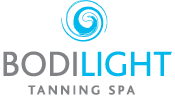TANNING FACTS
DID YOU KNOW?
Sunlight is energy, which is transferred by means of electro-magnetic rays or waves with different wave lengths. We can differentiate between ultra-violet rays (UV light), visible light, and warm infra-red radiation (IR light). The UV light is subdivided up into UV-A, UV-B and UV-C rays. The dangerous UV-C rays are filtered out by the atmosphere and do not reach the surface of the earth. The composition and strength of UV-A and UV-B rays varies and depends on the time of day and year, air pollution, degree of latitude North or South, and the intensity of reflection (water, snow etc) for example.
The skin is the largest regulatory and protective organ of our body. Through the skin we not only make physical contact but also sensual contact to our environment.
The production of melanin is the body’s inherent protection against sunlight. The UV-B rays encourage the cells of the epidermis ( the elanocytes) to produce more white melanin pigments, which, on their way to the upper dermal layer, are tanned by the UV-A rays and the oxygen contained in the blood ( indirect pigmentation ).
If a preliminary pigmentation has taken place already, the skin will be tanned immediately by UV-A rays (direct pigmentation) The pleasant effects of UV rays on the body and soul have been substantiated by medicine. The natural formation of vitamin D3 takes place only in the sun or on a sunbed – or put more precisely – under the influence of UV-B rays. Vitamin D3 is an important hormone for the protection of bone, protecting against osteoporosis. Due to the formation of vitamin D3 calcium is deposited in the bones.
Still further positive properties are attributed to this “sun hormone”. It stimulates the immune system, increases the body’s own physical powers, alleviates depressions and has a positive affect on the heart and circulation. Even skin diseases are treated with UV light with great success, such as acne, psoriasis and neurodermatitis.
SKIN TYPES
Depending on the type of skin, people react differently to sunlight. You should know your type of skin for correct enjoyment of the sun and sunbeds. World-wide, six types of skin are differentiated – the first four types of skin occur most frequently in Europe.
Skin type 1 ( approx 2% of all Central Europeans):
Remarkably light skin, reddish hair, blue eyes, very strong tendency to develop a sunburn.
Skin type 2 ( approx 12% of all Central Europeans):
Light skin, blond to medium-brown hair, blue to grey or green eyes, strong tendency to develop sunburn.
Skin type 3 ( approx 78% of all Central Europeans):
Normal skin, dark-blond to brown hair, grey to brown eyes, moderate tendency to develop a sunburn.
Skin type 4 ( approx 8% of all Central Europeans):
Light-brown to olive-coloured skin, dark hair and eyes, slight tendency to develop a sunburn.
Even in winter with little sunshine we can provide ourselves with the missing sunshine on a sunbed. Contrary to the natural sun, which is subject to strong variations, tanning on a sunbed can be used precisely and individually.

TANNING YOU CAN TRUST
Bodilight Tanning Spa is staffed at all times. The Spa is registered with the local Authority and we are members of the Sunbed association. All members of staff are fully trained in operating the tanning equipment and will be able to guide our clients with the recommended usage levels suitable to them. We provide a comprehensive range of tan accelerating lotions and after tan moisturisers for those clients wishing to enhance their tanning results further. Our staff can guide you on this during your visit.
